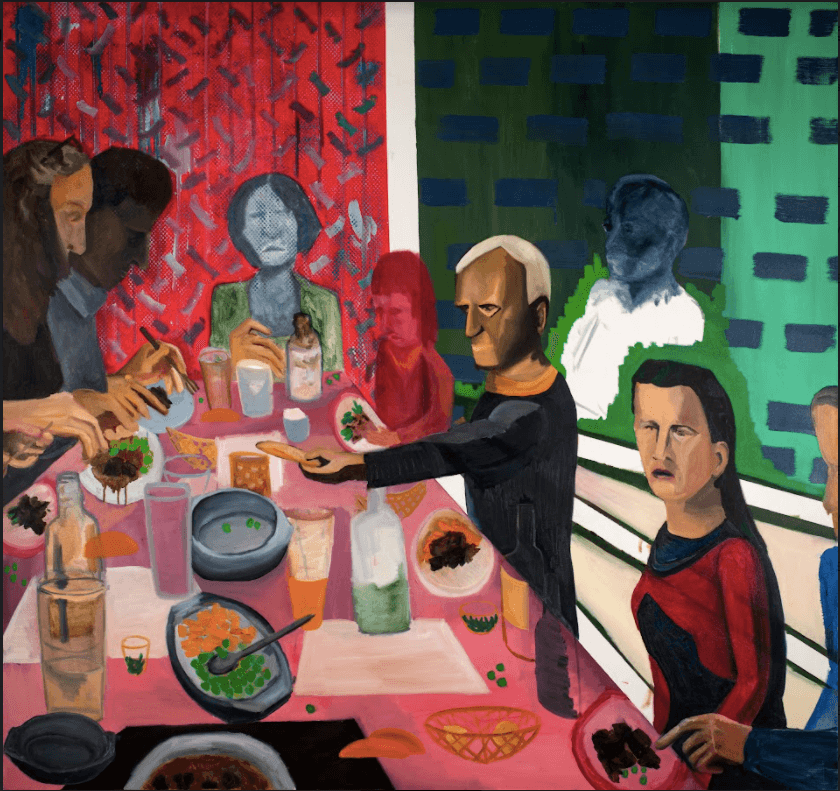Above: Detail from Archie Rand. 326: To Send the Impure from the Temple (Numbers 5:2), 2001-2006. From the series The 613. Acrylic on canvas. 20 x 16 in. Photo by Samantha Baskind
Artists on Their Art

Sara Benninga. Gathering, 2017. Oil on canvas. 67 x 71 in. Photo by Shai Halevi
In 2015 my father passed away. He was fairly young, sixty-eight years old, active and lively to his very last months, despite fighting an aggressive cancer. My father immigrated to Israel in 1973. Initially of Dutch origin, his family survived the Holocaust, came back to the Netherlands after the war, then moved to the United States when he was seven years old. My father was a large influence on my younger self. He was my link to the Netherlands, to a sense of universality, and he educated me to be social, interested, and active.
The scene they are taken from is a last meal before the arrival of death.
Featured here is one out of a number of paintings on the subject of family, which I made after his death. It shows a family meal, figures seated around a table on which lie an assortment of food bowls, cups, plates, and bottles. While the scene is descriptive, it is not intended to be realistic: not all the figures have a plate or utensils, there are too many bottles, and the size of the same objects varies. These objects express a gentle balance in the painting, they are part of painting itself, formed in action. They turn the table into a composition, and are essentially manifestations of paint—dots of orange and green, small fields of white, the crisscross pattern of raw sienna. The scene is based on a family photo I took on our last visit to Amsterdam with my father, while my great aunt, Sara Tromp, was also still alive. She lived there her whole life— including the Second World War, during which she hid in apartments around Amsterdam. She, as opposed to her sister—my Oma, Helen Benninga—never wanted to leave the Netherlands— not before nor after the Holocaust. On that last visit we went to a small restaurant in her neighborhood—she loved it (it was actually precooked Dutch food, defrosted, and not all that good), and there I took the photo. At the time I made the painting, my father had already died. Thus, I removed his figure from the circumference of the table—and planted him in that green bush to the right. In his place sits a little girl—she is colored in reds. The two figures closer to us—those with the space-wars look-alike outfits—are figures from a scene in Ingmar Bergman’s The Seventh Seal—a movie which impressed me with its ability to convey religious passion in visual form. The scene they are taken from is a last meal before the arrival of death. The background is divided into two parts—with different negating patterns—which create a sense of depth. So do the perspectival lines of the table.
This painting is expressive of the way I work. I do not have rigid rules for my image making. I mostly paint medium- to large-sized oil paintings, scaled to the human body viewing them. In this way I evoke an empathy, or at least some form of comparison between the figures in the painting and those outside it. While I work intuitively, developing areas of the painting as I go along, I often work around a theme. The theme is an emotional one, relying on memory and experience. The figure of my father appears half erased, in the bushes, or in the corner, testimony to his importance and absence. Assessing the growing sadness of departure or the expanding void between myself and his image after his death runs as an internal logic of this piece.
.
SARA BENNINGA is a painter and art historian. She lectures in the Department of Visual and Material Culture at Bezalel Academy of Art and Design, as well as in the Department of Art History at Tel Aviv University. She has exhibited her work in solo shows as well as in a number of group shows in Israel.